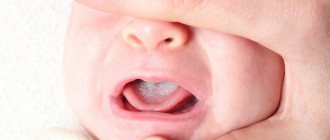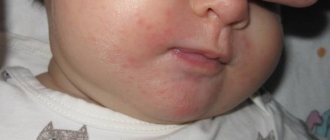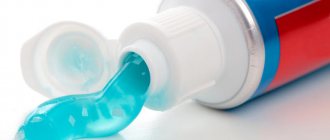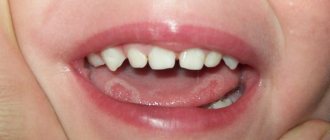Herpes on the lips
Pediatrician Alexandra Zhukovskaya talks about herpes infection on the lips.
For some, herpes is an unpleasant but common occurrence, appearing several times a year, while others know about this problem only by hearsay.
How can you distinguish herpes rashes?
Most often these are small bubbles located on and near the lips. The appearance process may be accompanied by a burning or tingling sensation. After some time, the bubbles burst, and in their place a crust forms, which disappears without a trace.
How can you get a herpes infection?
The virus is transmitted through close contact, through saliva, contaminated objects, during a kiss, through shared utensils, when sharing lipstick, and through sexual intercourse. The likelihood of contracting herpes is high from a person who has visible rashes.
How does the disease progress?
After entering the body, the virus reaches the nerve nodes, where it “hides”. There it can remain for the rest of its life and not make its presence known for a long time. Sometimes it is activated, sent to the skin, after which characteristic bubbles appear. That is, herpes on the lip indicates an exacerbation of a long-existing infection, and not a primary infection.
How does primary infection occur?
Often, the initial infection with a herpes infection has no symptoms and is not noticeable. But it happens that complications appear along with herpes:
- gingivostomatitis - inflammation of the oral mucosa and gums;
- an increase in temperature, accompanied by the appearance of blisters and ulcers in the mouth;
- herpetic panaritium (inflammation of the finger tissue) - the infection can spread to the fingers if they are pulled into the mouth;
- rashes can occur throughout the oral cavity, affecting the gums, which turn red and bleed. The child refuses to eat because the process becomes painful.
What is the reason for the exacerbation?
- emotional stress and fatigue
- exposure to sunlight
- changes in low and high temperature
- dry air
- presence of lesions in the lip area
- ARVI and other infections
- dehydration
- hormonal changes (in teenagers, during menstruation, etc.)
How to fight a “cold”?
If herpes appears for the first time or in a baby under 6 months, and the disease is accompanied by fever and affects not only the lips, then you need to consult a doctor for antiviral therapy.
Often recurrent infections go away on their own. But you can shorten their duration by using local antiherpetic agents (active ingredient acyclovir).
Ways to reduce discomfort:
- apply a cold compress to the area of the rash;
- avoid sour and spicy foods;
- choose cool drinks;
- if there is severe pain, then use ibuprofen or paracetamol;
- Do not use products containing lidocaine due to possible side effects or overdose.
How to prevent the spread of the virus:
- it is important to ensure that the child does not scratch the rash and wash his hands;
- use individual dishes, towels, toothbrushes for a child with a herpes infection;
- during an exacerbation, you should not engage in contact sports;
- a child with a “cold” on his lips should not kiss other people.
How to reduce the frequency of exacerbations?
The recommendations are very simple: follow a daily routine, eat well, walk in the fresh air, don’t be nervous, use sunscreen in the summer and chapstick in the winter.
If exacerbations of herpes occur more than 6 times a year, with accompanying complications, then the doctor may prescribe antiviral therapy.
Herpesvirus infections in children
Normally, every person is constantly home to a huge number of viruses, fungi and bacteria. Such permanent “residents” of our body include herpes viruses.
There are several species in the herpesvirus family, and they all have one thing in common - once they get into a person, they never leave him. When examining people for infection with these viruses, it turns out that 70.4% have herpes viruses type 1-2, 97.9% have varicella zoster (varicella zoster virus), 95% have cytomegalovirus, 97.5% have herpes virus type 6 , 95% have Epstein-Barr virus.
Primary infection with herpes viruses occurs in early childhood. Sometimes the virus enters the body asymptomatically, and sometimes it is accompanied by a clinical picture characteristic of the virus. Depending on the reactivity of the body and the state of its immunity, the disease can be quite severe.
Thus, the primary acute disease caused by type 1 herpes viruses is characterized by severe damage to the oral mucosa. The child has a high temperature for several days, he refuses to eat, intoxication is severe, painful ulcers appear in the mouth, the submandibular and cervical lymph nodes become enlarged and painful. Improvement may occur only by 5-7 days, and in some children recovery may take up to 2-3 weeks. In the future, under unfavorable conditions, the virus can rear its head again (recur), but its manifestations, as a rule, are not so severe - most often these are blistering rashes on the lips, which are popularly called a “cold.”
The chickenpox virus (Varicella zoster) also belongs to the herpesvirus family.
When meeting him, the child gets chickenpox. After this, immunity to the virus is developed, a person should no longer get chickenpox a second time (repeated cases of infection are extremely rarely diagnosed), but the virus does not completely leave the body, but remains dormant in the nerve ganglia. When the immune system is weakened (usually in older people), this viral infection recurs in the form of herpes zoster. Bubble elements appear on the skin along the peripheral nerves and in half of the cases along the intercostal nerves. The rash covers the torso like a belt (the word “zoster” in Greek means belt). This condition is accompanied by severe pain - neuralgia and, sometimes, general intoxication.
Herpes virus type 6 during primary infection can cause an acute infectious disease in a child, called sudden exanthema (infantile roseola, sixth disease). First, a high temperature occurs, which lasts an average of 3 days. In most cases, there are no catarrhal symptoms, only slight redness in the throat. Then, as the temperature drops, a red spotty rash appears, which lasts 1.5-2 days and disappears. If the child also received an antibiotic, this rash may be mistakenly regarded as a drug rash. Complications are rare. When the virus enters the latent stage, it most often does not manifest itself in any way. But its involvement in some diseases (for example, chronic fatigue syndrome) is discussed.
Cytomegalovirus and Epstein Barr Virus. Most often they quietly settle into the body, but sometimes in children they manifest themselves as a disease such as Infectious mononucleosis. It can be difficult. There is prolonged high fever, generalized enlargement of the lymph nodes, and especially the lymph nodes of the neck. They grow so large that they visually deform the neck, but they hardly hurt. Other lymphoid formations, such as tonsils and adenoids, also greatly increase. Because of this, the child cannot breathe through his nose and snores at night. Plaques, most often filmy, may appear on the tonsils. The liver and spleen may become enlarged, and sometimes a rash and jaundice may appear.
After suffering any of the above infections, during examination, blood tests determine antibodies specific to the specific virus involved in the disease. Only a doctor can interpret test results. And if the antibodies are positive, this does not mean that the infection is alive, and we must continue to fight it. Most often, this is a memory of an encounter with the virus, and only a doctor can tell you whether it is still active or not.
No need to treat tests! It is necessary to treat the child if his condition requires it.
In each specific case, the doctor will prescribe treatment; sometimes hospitalization is required due to severe infection.
The parents' task is to consult a doctor in time.
And after recovery, follow certain rules so that the immune response is adequate and the infection no longer rears its head.
After an infection, the child’s immune defense remains reduced for a long time and he needs:
- avoid contact with other infectious patients, hypothermia and overheating for about 3 months;
- if necessary, medical withdrawal from vaccinations is recommended;
- It is advisable to follow an antiherpetic diet.
The anti-herpes diet is based on the ratio of two essential amino acids - arginine and lysine.
Lysine suppresses herpes viruses, arginine promotes their reproduction. Products rich in lysine: milk, curdled milk, fermented baked milk, cheese, cottage cheese, yoghurts containing live bacteria, potatoes, fish, pork, vegetables, white chicken, soybeans, lentils, brewer's yeast.
Arginine: chocolate, sugar, raisins, sesame seeds, seeds, nuts (especially peanuts), cereals, wheat bread, oranges and tangerines.
Be healthy!
about the author
- Dobrelya Ekaterina Alexandrovna
- Pediatrician, infectious disease specialist of the highest category
- All publications by the author
“Mom, my mouth hurts!” We talk about stomatitis in children
Is your child being capricious, refusing food, or complaining of pain in the mouth? One of the reasons for this condition may be stomatitis. Alla Aleksandrovna Zmanovskaya, a dentist at Clinic Expert in Irkutsk, told us about the signs of stomatitis in children, methods of diagnosing and treating it.
— Alla Alexandrovna, what is stomatitis?
This is an inflammation of the mucous membrane of any part of the oral cavity - lips, cheeks, tongue, palate, gums.
— Why does stomatitis occur in children?
One of the reasons for the development of stomatitis may be damage to the mucous membrane as a result of mechanical and chemical trauma. There are frequent cases of injury to the mucous membrane by sharp edges of teeth. One type of stomatitis, Bednar's aphthae, develops due to trauma to the oral cavity from a rough pacifier. The availability of household chemicals to a child can cause a chemical burn to the oral cavity.
Viral, bacterial and fungal stomatitis develop against the background of infection with pathogens of ARVI, influenza, herpes, measles, rubella, specific infections (tuberculosis, syphilis, etc.), with weakened immunity, with pathology of certain organs and systems, in particular the gastrointestinal tract , as well as for allergic reactions. Fungal stomatitis can develop due to the use of antibiotics.
— Tell us about the existing types of stomatitis in children and their differences
There are acute and chronic forms of this pathological process. Depending on the elements of tissue damage, catarrhal, ulcerative and aphthous stomatitis are distinguished. They differ from each other both in symptoms and severity, and in treatment tactics.
Acute herpetic stomatitis is a common type of disease in children aged 6 months to 3 years. During this period, children lose antibodies received from the mother while the fetus is in the womb, and their own immunity is not yet ready for an adequate response. With age, there is a decrease in the incidence of this form of stomatitis due to the development of acquired immunity after suffering various forms of herpetic infection.
Infants and children who have undergone long-term antibiotic therapy often develop candidal stomatitis.
— What are the symptoms of stomatitis in children?
Parents may notice rashes on the oral mucosa - blisters, spots, ulcers, erosions, and feel bad breath. Young children become more capricious and refuse foods that especially irritate the inflamed mucous membrane (sour, salty). An older child usually points to the place where it hurts. With more severe stomatitis in children, body temperature may increase. Detection of these signs is a good reason to immediately contact a pediatric dentist.
— What is the diagnosis of stomatitis in children based on?
To make a diagnosis, we first talk with the adults accompanying the child - we find out the complaints, clarify when and how the disease began, how long it has lasted, and what chronic pathologies the child suffers from. Then we move on to examining the oral cavity, recording all changes in the mucous membrane and teeth. An external examination of the maxillofacial area is also carried out. In severe cases of some types of stomatitis in children, rashes on the lips and enlarged regional lymph nodes can be detected.
— What methods of treating stomatitis in children are currently relevant?
Depending on the severity of the disease, local or complex treatment is used. For example, in the case of the development of stomatitis as a result of mechanical damage, it is sufficient to eliminate the action of the causative factor (avoid the use of rough nipples, grind off sharp edges of teeth, etc.), antiseptic treatment of the oral cavity and the use of drugs for regeneration of the mucous membrane against the background of complete sanitation and elimination of the damaging factor a. For chemical burns, depending on the severity, hospitalization is indicated.
For viral, bacterial and fungal stomatitis of moderate and severe severity, in addition to local treatment, antiviral, antifungal or antibacterial therapy is additionally prescribed.
For any form of stomatitis, children should limit their consumption of coarse, hard, irritating foods.
Based on how long it takes for a child’s stomatitis to go away, we can draw a conclusion about the effectiveness of the treatment used and, if necessary, adjust it. Any form of stomatitis is cured within one to two weeks. However, it should be remembered that a feature of stomatitis in an HIV-infected child is that its course, even with appropriate treatment, is delayed for more than 2 weeks.
— Alla Alexandrovna, is it possible to prevent the development of stomatitis?
Can. The main method of prevention is sanitation of the oral cavity, which involves treatment of all teeth affected by caries and its complications, regular thorough oral hygiene, disinfection of premises, household items, and toys.
If a child often has stomatitis, you should consult a dentist and pediatrician, who, if necessary, will prescribe a comprehensive examination. It is important that children receive a nutritious, balanced diet and spend a lot of time outdoors. Hardening the body and playing sports also help the body resist infections.
If you suspect or detect signs of stomatitis in a child, I recommend that you contact a pediatric dentist. By eliminating possible causes and choosing the right therapy, the doctor will be able to prevent oral inflammation from becoming chronic.
For reference:
Zmanovskaya Alla Alexandrovna
In 2015 she graduated from the Faculty of Dentistry of Irkutsk State Medical University.
In 2021, she completed her internship at the Federal State Budgetary Educational Institution ISMU in the specialty “General Dentistry”.
In 2021, she underwent professional retraining at the Federal State Budgetary Educational Institution ISMU in the specialty “Therapeutic Dentistry”, in 2021 – in the specialty “Pediatric Dentistry”.
Dentist-therapist, pediatric dentist at “Clinic Expert” Irkutsk. Receives at the address: Irkutsk st. Kozhova, 9a










